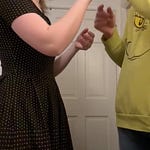Love speaks in many ways—a look, a smirk, a gesture. My autistic brother, Tommy, has always shown his love by laying his head on my shoulder and draping my hair over his own. He never says a word, but the message is clear.
While I understand Tommy’s ways of communicating, it’s essential that individuals with profound autism have a functional way to express themselves—not just with loved ones, but in the broader community.
Communication is a fundamental human right, and access to it is a matter of dignity.
For Tommy, that looks like American Sign Language (ASL), a picture communication system on his iPad, and gestures for non-signers. I always tell people—don’t worry if you don’t know ASL. Tommy is persistent—he’ll make sure you understand what he needs!
As inclusion advocates, we must ask ourselves:
🌻 Are we fostering communities where all forms of communication are valued?
🌻 Are we improving access so that everyone can participate fully?
🌻 Are we intentional in our teaching to support meaningful connection?
Inclusive communication isn’t just about speech—it’s about ensuring every voice is heard. Let’s build spaces where that’s the norm.
How are you making communication more accessible in your community?












Share this post